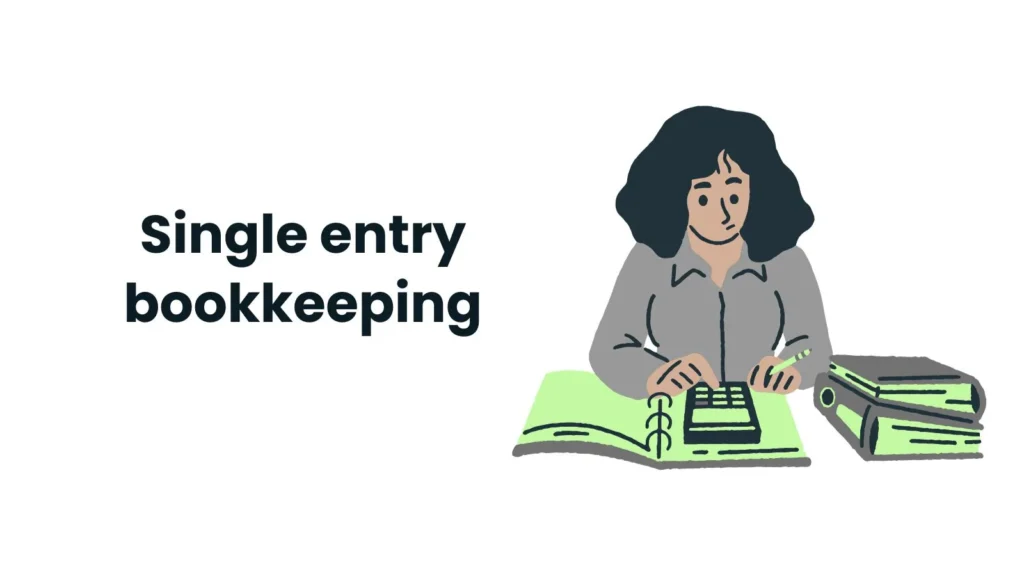Updated on October 7, 2024
Navigating the world of bookkeeping can be daunting, especially for beginners. Whether you’re a budding entrepreneur or someone looking to understand the financial side of a business better, understanding the basics of single entry bookkeeping is crucial. This comprehensive guide aims to shed light on the single-entry system: how it works, its advantages and limitations, and how it compares to the double-entry system.
Key Takeaways:
- In single entry bookkeeping, each transaction is recorded once in a cash book, primarily focusing on cash inflows (revenues) and outflows (expenses).
- Single entry bookkeeping is best suited for small businesses. It’s not adequate enough for businesses with inventory.
- Single entry records one entry per transaction, whereas double-entry bookkeeping involves two: a debit in one account and a credit in another.
- Transitioning from single-entry to double-entry is possible with expert guidance.
- Expanding your single entry system can enhance financial tracking and decision-making.
- Creating profit and loss reports and performing bank reconciliations are essential for financial accuracy.
What is Single Entry Bookkeeping?
Single entry bookkeeping is a simplified accounting method that records each financial transaction just once, typically in a cash book. This system is primarily used by small businesses or sole proprietors due to its straightforward nature and ease of use. Unlike double-entry bookkeeping, where every transaction affects at least two accounts (debit and credit), single entry focuses mainly on cash inflows and outflows, providing a one-sided view of financial activities.

How the Single Entry System Works
In single entry bookkeeping, you use a cash book to record money earned and spent. You start with the cash balance for a certain period, add money you receive, and subtract money you pay out. After recording all these money movements, you find out the final cash balance at the close of that period.
The typical details in a standard cash book include:
- Date: The day of the money transaction.
- Description: A brief note about the transaction.
- Transaction Value: The number can either be positive (income) or negative (expense).
- Balance: The total cash you have after each transaction.
While it’s possible to split revenue and expenses into separate columns, this method still qualifies as single entry bookkeeping since each accounting transaction is recorded on a single line.

Benefits and Advantages of Single Entry Bookkeeping
Advantages of Single Entry System
- Ease of Use: Single entry bookkeeping offers a straightforward method of recording transactions, making it easier for individuals without an accounting background.
- Suitable for Small Businesses: The system is ideal for small businesses with fewer transactions, providing a clear overview of cash flow.
- Cost-Effective: It doesn’t require complex accounting software or tools. A basic ledger or cash register is often sufficient.
- Time Efficient: Recording transactions in a single ledger saves time compared to the more detailed double-entry system.
Limitations of Single Entry Bookkeeping
Disadvantages of Single Entry System
- Limited Financial Insight: This method does not provide a comprehensive view of a business’s financial health, as it fails to track assets and liabilities separately.
- Error Prone: Since there is no balancing of debits and credits, errors can go unnoticed, making reconciliation difficult.
- Inadequate for Larger Businesses: Single-entry bookkeeping may not suffice for larger enterprises with more complex financial needs, as it lacks the depth required for thorough financial analysis.
- Lack of Error Detection: Unlike the double-entry system where discrepancies can be spotted if debits and credits don’t match, the single-entry system doesn’t have a built-in mechanism for error detection or correction.
- Limited Financial Reporting: The information recorded isn’t sufficient for comprehensive financial reporting, making it challenging to track business performance or make informed decisions.

Eligibility Criteria: Who Should Use Single Entry Bookkeeping?
Single entry bookkeeping is best suited for:
- **Small Businesses:** With fewer transactions and straightforward financial activities.
- **Sole Proprietors:** Individuals managing their own finances without the need for detailed tracking.
- **Startups:** New businesses in the early stages with simple financial operations.
- **Freelancers and Consultants:** Professionals who need to track income and expenses without complex accounting.
However, businesses with inventory, multiple revenue streams, or those anticipating significant growth may find single entry insufficient and consider transitioning to double-entry bookkeeping.
How to Implement Single Entry Bookkeeping
Creating a Cash Book
A cash book is the primary tool in single entry bookkeeping. Here’s how to set one up:
- Date: Record the date of each transaction.
- Description: Provide a brief description of the transaction.
- Income/Expenses: Indicate whether the transaction is an income or an expense.
- Amount: Enter the amount associated with the transaction.
- Balance: Maintain a running balance after each transaction.
Using spreadsheet software like Microsoft Excel or Google Sheets can enhance accuracy and provide automated calculations, making bookkeeping more efficient.
Expanding Your Single Entry Bookkeeping System
To track your finances more precisely, consider adding a bit more structure to your single entry bookkeeping spreadsheet. Here’s how you can do it:
Create Detailed Columns
Separate Income and Expense Types:
Allocate a distinct column for various types of sales and expenses. This allows you to track how much revenue or cost is associated with each category. You might have columns labeled, for example, as “Product Sales,” “Consulting Fees,” “Office Supplies,” and “Utilities.”
Account-Specific Columns:
Each column represents a different account within your bookkeeping system. This could include a “Bank Account” column, a “Stationery Account,” and an “Internet Account.” These allow for more precise tracking and categorization of financial activities.
Ensure Accurate Totals
Make sure the sum of numbers across each row equals the sum of numbers down each column. This double-check helps maintain the accuracy of your records.
Maintain a Running Balance
Calculate the difference between total income and total expenses. Record this figure just below the income column as a ‘carry forward’ (c/f) amount. This helps you keep track of your financial standing at a glance.
For a comprehensive understanding of your finances, conduct regular bank reconciliations, ensuring every transaction is accounted for accurately, just like in more complex bookkeeping methods.
By expanding your single entry system in this way, you’re taking a significant step towards more detailed and organized financial tracking, enabling better decision-making for your business or personal finances.
Creating Financial Reports
How to Create a Profit and Loss Report Using a Single Entry Cash Book
Creating a Profit and Loss (P&L) report from a single-entry cash book is a straightforward process. This report, also known as an Income Statement, helps assess the profitability of your business. Here’s how you can effectively compile one:
Step 1: Gather Your Financial Data
Start by collecting all your financial entries. Ensure you have recorded all your income and expenses accurately over the period you wish to report.
Step 2: Organize Your Entries
- Income: List all sources of income. This includes sales revenue, interest, and any other earnings.
- Expenses: Categorize your expenses. Common categories might include utilities, rent, supplies, and salaries.
Step 3: Calculate Total Income
Add up all your income sources. This gives you a clear picture of your gross earnings for the period.
Step 4: Calculate Total Expenses
Sum up all your expenses. Accurate categorization here can help you identify where most of your money is going.
Step 5: Determine Net Profit or Loss
Subtract the total expenses from the total income:
Net Income = Total Income – Total Expenses
If your income exceeds your expenses, your business is profitable, indicating you have a Net Profit. Conversely, if expenses surpass income, it’s a Net Loss, signaling a need for strategic adjustments.
Step 6: Analyze the Results
- If you’re generating profit, consider areas for reinvestment.
- If experiencing a loss, evaluate where expenses can be cut or income increased to transition to profitability.
Enhanced Clarity with Visualization: For easier interpretation, consider using graphs or charts. Tools like Microsoft Excel or Google Sheets can aid in creating visual representations of your data, making trends and patterns more apparent.
Regular Review and Adjustment: Incorporate this reporting process routinely, perhaps monthly or quarterly. Regular evaluations help track performance over time, aiding in timely and informed business decisions.
By following these steps, you can efficiently create a P&L report that not only documents past performance but also guides future business strategies.
How to Make a Balance Sheet Report from Single Entry Bookkeeping
If at some stage you require a balance sheet, you can transition your single entry bookkeeping records to create one. Here’s how:
Steps to Develop a Balance Sheet
- Organize Single Entry Records: Ensure your single entry records are complete and up to date. This includes all sales, purchases, expenses, and revenues.
- Calculate Receivables and Payables: Determine the amounts your customers owe you, as well as the debts you owe to creditors.
- Consult with an Accountant: Your accountant can help transfer your single entry records into a double entry system, categorizing information into assets, liabilities, and equity.
- Use Accounting Software: Reliable accounting software can simplify the process by automatically categorizing entries and converting them into a balance sheet format.
- Understand the Structure: A balance sheet consists of three main sections: assets, liabilities, and equity.
- Ensure Accuracy: Double-check all figures for consistency and accuracy to prevent incorrect financial insights.
Why a Balance Sheet Matters:
- Loan Applications: Banks often require a balance sheet to assess your financial viability when applying for loans.
- Business Valuation: Potential buyers need a detailed financial picture to evaluate the value and health of the business.
By following these steps, you’ll transform your single entry records into a powerful tool that not only demonstrates your business’s financial health but also supports informed decision-making.
Transitioning from Single Entry to Double Entry Bookkeeping
As your business grows, the complexity of financial transactions increases, making single entry bookkeeping less effective. Transitioning to double-entry bookkeeping provides a more comprehensive financial overview. Here’s how to make the switch:
Steps to Transition from Single to Double Entry Bookkeeping:
- Assess Your Current System: Evaluate your current single-entry bookkeeping process to ensure you are confidently managing your cashbook.
- Understand the Double-Entry System: Familiarize yourself with double-entry bookkeeping, where each transaction affects at least two accounts, maintaining the accounting equation (Assets = Liabilities + Equity).
- Prepare Your Financial Records: Organize existing financial records to align with the double-entry format, categorizing transactions into debits and credits.
- Seek Expert Guidance: Consult with an accountant or financial expert to guide you through the transition, ensuring accuracy and compliance.
- Implement and Monitor: Once transitioned, implement the double-entry system and regularly review financial statements to ensure accuracy.
By following these steps, you can smoothly transition to a double-entry bookkeeping system, gaining a comprehensive view of your financial health.
Frequently Asked Questions (FAQs)
Can single entry bookkeeping track assets and liabilities?
No, single entry bookkeeping primarily focuses on recording cash coming in (revenue) and cash going out (expenses). It does not adequately track assets, liabilities, or owner’s equity. For a more comprehensive financial picture that includes assets and liabilities, the double-entry system is preferred.
Is single entry bookkeeping suitable for businesses with inventory?
The single-entry system is primarily appropriate for small enterprises with simpler financial transactions. While it can be used to track basic income and expenses, it may not be adequate for businesses with inventory that require detailed tracking of goods, cost of goods sold, and inventory valuation. Larger or more complex businesses, especially those with inventory, would benefit from the double-entry system due to its comprehensive nature.
Can I switch from single-entry to double-entry bookkeeping?
Yes, businesses can transition from single-entry to double-entry bookkeeping. The double-entry system is suitable for businesses of all sizes and provides a complete picture of finances. Switching would involve a more detailed recording process, capturing transactions in at least two accounts (as debits and credits). It’s advisable to consult with an accountant or financial expert during the transition to ensure accuracy and compliance.
How can you expand a single entry bookkeeping spreadsheet for more detailed tracking?
To expand your single entry bookkeeping spreadsheet for enhanced tracking, consider creating detailed columns for separate income and expense types, account-specific columns, ensuring accurate totals, maintaining a running balance, and conducting regular bank reconciliations.
How do you create a profit and loss report from a single entry cash book?
Creating a Profit and Loss (P&L) report from a single-entry cash book involves gathering financial data, organizing entries into income and expenses, calculating total income and expenses, determining net profit or loss, and analyzing the results. Visualization tools like graphs can enhance clarity.
How do you perform a bank reconciliation for a single entry cash book?
Performing a bank reconciliation involves comparing entries in the cash book with the bank statement, addressing outstanding checks, tackling deposits in transit, excluding non-bank transactions, and ensuring the adjusted totals match to achieve balance.
What tools can be used to create a cash book for single entry bookkeeping?
Tools for creating a cash book in single entry bookkeeping include manual methods like a ledger notebook and calculator, as well as digital solutions like Microsoft Excel, Google Sheets, and LibreOffice Calc, which offer user-friendly features and automation.
How can a balance sheet be created from single entry bookkeeping records?
Creating a balance sheet from single entry bookkeeping records involves organizing records, calculating receivables and payables, consulting with an accountant, using accounting software, understanding the structure of a balance sheet, and ensuring accuracy in all figures.
Why might a business need a balance sheet?
A business might need a balance sheet to secure loans, attract buyers, evaluate financial health, engage in strategic planning, and meet regulatory or stakeholder requirements by providing a detailed overview of assets, liabilities, and equity.
Why is it important to generate a profit and loss report?
Generating a Profit and Loss report is crucial for evaluating business viability, strategic decision-making, financial transparency, meeting investor and lender requirements, and facilitating tailored planning for growth and resource allocation.
Conclusion
Single entry bookkeeping serves as a foundational system for many small businesses and individuals. While it offers simplicity and ease of use, it’s essential to recognize its limitations, especially when compared to the double-entry system. As your business grows and financial transactions become more complex, you might consider transitioning to a more comprehensive bookkeeping system. Regardless of the method you choose, maintaining accurate financial records is paramount for the success and sustainability of any business.
Explore More:
Additional Resources
For more detailed guides and templates, explore our resources:




 anywhere
anywhere  anytime
anytime